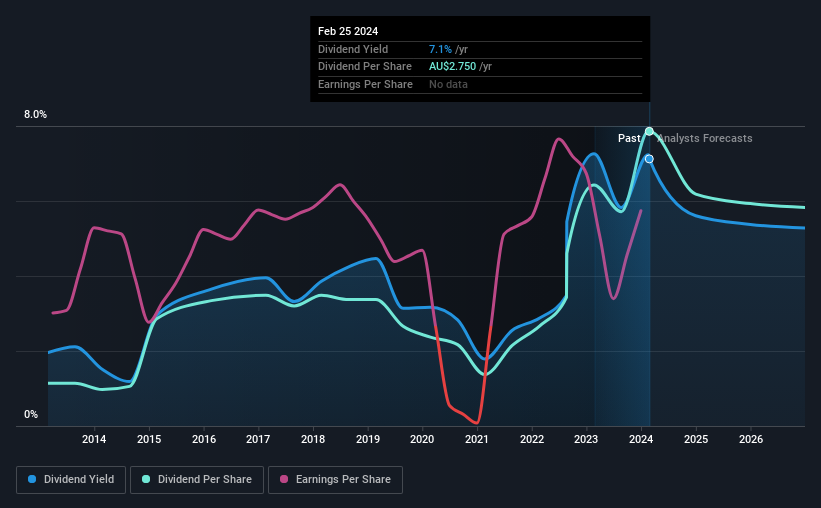Do These 3 Checks Before Buying Ampol Limited (ASX:ALD) For Its Upcoming Dividend
Readers hoping to buy Ampol Limited (ASX:ALD) for its dividend will need to make their move shortly, as the stock is about to trade ex-dividend. The ex-dividend date is one business day before the record date, which is the cut-off date for shareholders to be present on the company's books to be eligible for a dividend payment. The ex-dividend date is an important date to be aware of as any purchase of the stock made on or after this date might mean a late settlement that doesn't show on the record date. Accordingly, Ampol investors that purchase the stock on or after the 1st of March will not receive the dividend, which will be paid on the 27th of March.
The company's next dividend payment will be AU$1.80 per share, and in the last 12 months, the company paid a total of AU$2.75 per share. Last year's total dividend payments show that Ampol has a trailing yield of 7.1% on the current share price of AU$38.61. Dividends are a major contributor to investment returns for long term holders, but only if the dividend continues to be paid. As a result, readers should always check whether Ampol has been able to grow its dividends, or if the dividend might be cut.
See our latest analysis for Ampol
Dividends are usually paid out of company profits, so if a company pays out more than it earned then its dividend is usually at greater risk of being cut. Last year Ampol paid out 93% of its profits as dividends to shareholders, suggesting the dividend is not well covered by earnings. A useful secondary check can be to evaluate whether Ampol generated enough free cash flow to afford its dividend. It paid out more than half (62%) of its free cash flow in the past year, which is within an average range for most companies.
It's good to see that while Ampol's dividends were not well covered by profits, at least they are affordable from a cash perspective. Still, if the company continues paying out such a high percentage of its profits, the dividend could be at risk if business turns sour.
Click here to see the company's payout ratio, plus analyst estimates of its future dividends.
Have Earnings And Dividends Been Growing?
Stocks with flat earnings can still be attractive dividend payers, but it is important to be more conservative with your approach and demand a greater margin for safety when it comes to dividend sustainability. If earnings fall far enough, the company could be forced to cut its dividend. That explains why we're not overly excited about Ampol's flat earnings over the past five years. We'd take that over an earnings decline any day, but in the long run, the best dividend stocks all grow their earnings per share.
The main way most investors will assess a company's dividend prospects is by checking the historical rate of dividend growth. Ampol has delivered 21% dividend growth per year on average over the past 10 years.
Final Takeaway
From a dividend perspective, should investors buy or avoid Ampol? Earnings per share have barely moved in recent times, and the company is paying out an uncomfortably high percentage of its income. Fortunately its cash generation was somewhat stronger. It's not that we think Ampol is a bad company, but these characteristics don't generally lead to outstanding dividend performance.
So if you're still interested in Ampol despite it's poor dividend qualities, you should be well informed on some of the risks facing this stock. In terms of investment risks, we've identified 2 warning signs with Ampol and understanding them should be part of your investment process.
A common investing mistake is buying the first interesting stock you see. Here you can find a full list of high-yield dividend stocks.
Have feedback on this article? Concerned about the content? Get in touch with us directly. Alternatively, email editorial-team (at) simplywallst.com.
This article by Simply Wall St is general in nature. We provide commentary based on historical data and analyst forecasts only using an unbiased methodology and our articles are not intended to be financial advice. It does not constitute a recommendation to buy or sell any stock, and does not take account of your objectives, or your financial situation. We aim to bring you long-term focused analysis driven by fundamental data. Note that our analysis may not factor in the latest price-sensitive company announcements or qualitative material. Simply Wall St has no position in any stocks mentioned.

 Yahoo Finance
Yahoo Finance 